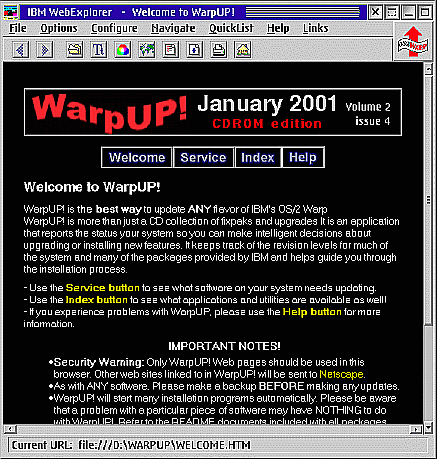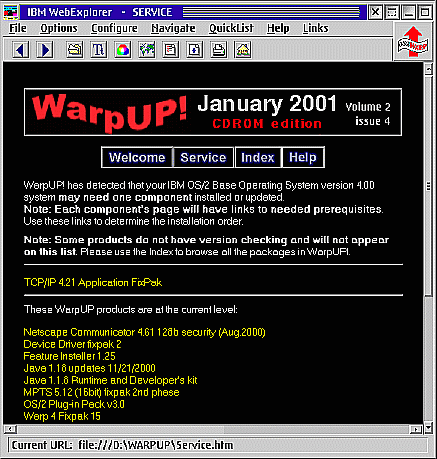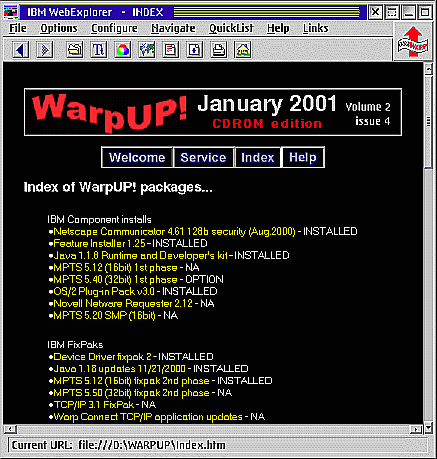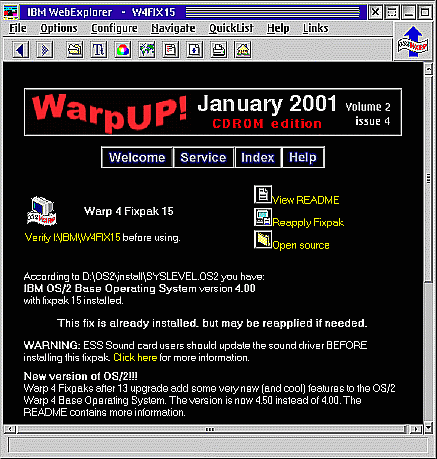
16 March 2001
 Marco J. Shmerykowsky, P.E. is a professional structural engineer and
computer consultant in New York City with SCE Computer Solutions.
Marco J. Shmerykowsky, P.E. is a professional structural engineer and
computer consultant in New York City with SCE Computer Solutions.
If you have a comment about the content
of this article, please feel free to vent in the OS/2 eZine discussion forums.
|
Previous Article |
|
Next Article |

WarpUP! - (January 2001 Edition)
Recently I added an HP print server to my office network. Since we live in a Microsoft Windows world, it was a obvious that the hardware would come
with the appropriate software to get the device properly working. OS/2, however, was another matter. After talking to a few people on OS/2
newsgroups and mailing lists, I decided to use the TCP/IP print utilities (ie. LPR). It should have been a simple process, but there was a "bug"
somewhere in the various versions of key system files that I had on my system. I needed to apply some patches.
Most users are probably painfully aware of what comes next after the realization that you need to find fixes and patches to the system. First,
you need to do your research by combing thru newsgroups, web sites, and mailing lists to find something which comes close to your problem.
The next step is to track down the appropriate fix pack and any "prerequisites" to the needed patches. Finally, you have to get the patches
downloaded and installed. Hopefully when everything is finished, your system still works. In general, although the "detective work" may be
enjoyable from a problem solving perspective (I am an engineer after all,) the process is a royal pain in the neck. Most people have better
things to do with their time than trying to get an operating system to work. If they didn't, they would probably being using an operating
system developed in a certain west coast state.
Fortunately for us, Duane A. Chamblee at Indelible Blue has created for us a fabulous resource called WarpUp! for all of the OS/2 users who need or want to bring their system up to the latest service levels. Not only does the product have the latest versions of the necessary fixpacks for the base OS, the device drivers, 16 bit MPTS, 32 bit MPTS, TCP/IP and Java, but it also has a unified interface which aids in the application of these fixes. The product ships in "client" and "server" editions. In addition to all of the patches, updates, and programs contained on the "client" edition, the "server" edition contains Warp Server Fixpaks, the Apache web server with PHP support, the Perl language interpreter, MySQL/2 3.22.26a database server, and the IBM GoServer web server.
Installation
The installation process consists of running the "install.cmd" script from the WarpUP! CD. This script will copy the WarpUP! program files to your boot drive, create a program icon on your desktop and perform an initial scan of your system. Once the scan is completed, the scripts launch OS/2's original web browser, Web Explorer, and load the WarpUP! "welcome page."
Using WarpUP!
The "welcome page" has some general descriptions about the product and the usual warnings about backing up your system before applying any updates. Finally, this page introduces the user to WarpUP's three main sections: service, index, and help.The "service page" is the interface to WarpUp!'s primary mission - intelligent system upgrading. Upon running WarpUp for the first time, the tool will scan the various service levels of the installed products on your machine and will generate two "service lists." The first service list contains the items on your system which WarpUp! can upgrade. For example, when WarpUp! is run for the first time on a newly built Warp 4 system, the service list contains line items for Warp 4 Fixpak 15, Device Driver Fixpak 2, the Warp 4 Peer Fixpak, the MPTS 5.12 level 1 and level 2 fixpaks, and a number of other items. The second "service list" contains the WarpUP! products which have already been installed or detected on your system. Thus, as you apply updates and patches, WarpUP dynamically regenerates the "service page" in order to accurately reflect the current service level of your system. As the various patches are applied, the list of serviceable items will shrink and the "current service level" items will increase.

The other page which relates to serviceable items is the "index page." This web page contains hyperlinks to all of the products which are available for installation from the WarpUP! CD. Each product/item on the page also contains a status note which indicates whether a specific item has been installed, may be installed "optionally," or if it does not apply (i.e.. NA) to the system being serviced. This index is primarily used to access products which either do not have automatic version detection routines or which are not "primary components. Examples of such components include the latest HP LaserJet printer drivers, the latest SciTech Special Edition video drivers, and Christian Langanke's animated mouse pointers.

The process for upgrading any particular component consists of selecting an item from a either one of the "service lists" or from the WarpUP! index page. This brings up what may be described as a "product page" in Web Explorer. Each "product page" typically contains hyperlinks for the patch file's associated readme file, the installation script or program, a link to the "source" files, and a link which allows for "verification" of the files on the CD. Finally, each "product page" displays information about any "prerequisite" patches which must be installed, hyperlinks to these required patches, and general information and warnings about the patch or product about to be installed.

The installation programs launched by WarpUP! consist of the latest edition of the well known "Corrective Service Facility" program, standard OS/2 installation programs such as the one which installs Netscape, and scripts such as the one which copies the danis506.add file to the appropriate location and updates the config.sys file to reference the new driver. In general, the installation routines are the standard routines that every OS/2 user has encountered in the past. The main difference is that the creation of "disk images" is not required and WarpUP! takes care of figuring out what to run. Once a product is installed, the browser icon in Web Explorer changes from a "red" arrow to a "blue" arrow to indicate the an installed status.
The "verification" link scans each file contained within a certain patch to verify that the file has not been corrupted for some reason. This ensures that a patch will not be applied in such a manner where a corrupted file is quietly slipped into "production" and will create a mysteriously unstable system. As someone who has experienced temperamental CD writers, the is a welcome feature.
The final section which can be accessed from the "welcome page" is the "help page." This page provides general help information with respect to the WarpUP! tool but not to individual fixes and patches. The informational text for the patches can be located by following the source link on a product page.
Summary
After trying WarpUP! on a few different Warp 4 systems ranging in service levels from "fresh install" to Fixpak 13, I only encountered one minor problem. For some reason, WarpUP!'s automatic detection routines always detected "TCP/IP version 4.1" as being installed and consequently recommended that the "TCP/IP 4.21 Application Fixpak" should be installed. The correct "TCP/IP application fixpak" for the test systems was the "TCP/IP 3.1/4.0 Application Fixpak."This problem, however, served to illustrate two excellent "features" with respect to the tool's design and logic. First, since each patch has a description and a listing of the required prerequisite patches, a user has a chance to take control of the patch process. One of the reasons I found the concept of the WarpUP tool appealing was that it would identify the patches I needed to apply. However, when I read the description of one patch it was recommending, I realized that something was amiss. Thus, I was able to take full control of the update process as the end-user. With some help from Duane Chamblee, we quickly identified the correct update to apply. Although a "typo" in the WarpUP! scripts prevented the appropriate patch from launching from within WarpUP!'s user interface, it was very easy to launch the needed update process from the command line.
One final item users should be aware of relates to the installation of the Java 1.1.8 Runtime and Developer's kit. The WarpUP! product page contains a warning that states that the "installation from CD-ROM can be VERY, VERY slow." From my experience, this is an accurate assessment with older machines. On older Pentium based machines, the CD-ROM's would somehow "time-out" in both the IBM installation procedure and the during a straight forward xcopy procedure. On a more modern Pentium III, the full installation was accomplished flawlessly from the CD-ROM.
In general, the WarpUP! CD provides an excellent, hassle free way to update your OS/2 system. Rather than spending days tracking down fixes
and patches, you can get your system fully updated in an evening. The product is definitely worth the price and I highly recommend it.
WarpUP! - January 2001 Edition
Price: WarpUP! Client - $19.00 US, WarpUP! Server - $30.00 US from Indelible Blue
E-mail: warpup@indelible-blue.com
|
Previous Article |
|
Next Article |